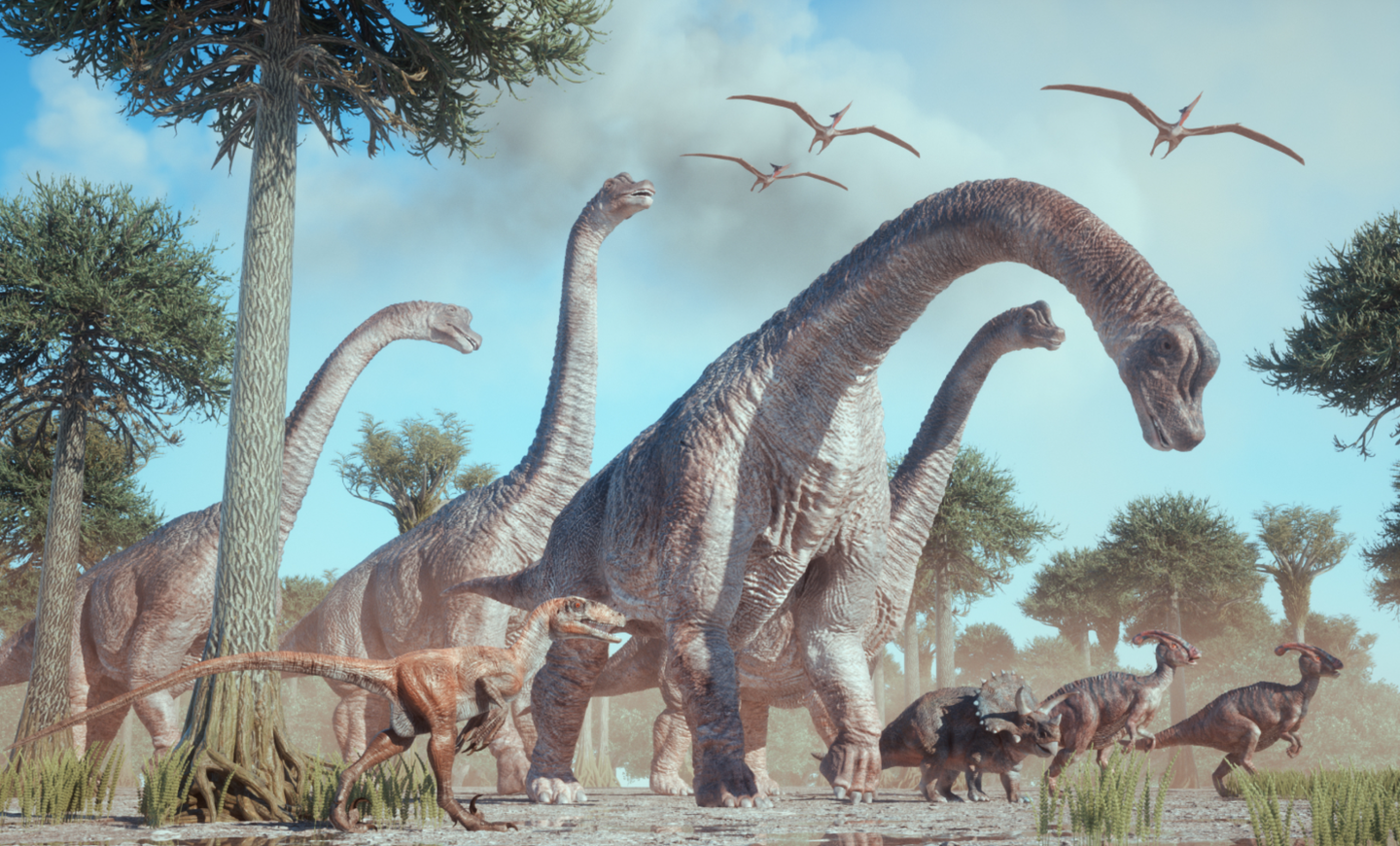Dinosaur tracks reveal mixed species travelled together in herds like modern mammals
New dinosaur footprints in Canada reveal rare mixed-species herding behavior and predator-prey interaction from 76 million years ago.

A groundbreaking discovery of dinosaur footprints in Alberta’s Dinosaur Provincial Park reveals a rare moment of ancient social behavior. The tracks show multiple species walking together, hinting at a survival strategy against predators 76 million years ago. (CREDIT: Orla/Getty Images)
Deep in Alberta’s Dinosaur Provincial Park, a rare discovery is rewriting what scientists know about dinosaur behavior. For over a century, this park has yielded thousands of fossilized bones. But in 2024, a different kind of relic emerged—footprints. Dozens of them, from different species walking together, revealed a story frozen in time.
Researchers uncovered these ancient steps during an international field course. What they found was astonishing: multiple dinosaur species moving together as if part of a herd. This tracksite, now known as the Skyline Tracksite, contains the first natural mold dinosaur footprints ever found in the park and marks the first documented mixed-species trackway in the region.
Tracks Reveal a Snapshot of Cretaceous Life
The new tracksite captures a dynamic moment from 76 million years ago. Thirteen distinct horned dinosaur (ceratopsid) prints, likely made by at least five animals walking side by side, were found. An armored ankylosaur's footprint was embedded among them, indicating it traveled with the group. The layout suggests the animals moved together in a coordinated way.
This idea of mixed-species herding is rare in dinosaur records. Similar to how zebras and wildebeests move together today, these dinosaurs may have teamed up for protection. Dr. Brian Pickles from the University of Reading said, “It was incredibly exciting to be walking in the footsteps of dinosaurs 76 million years after they laid them down.”
Nearby, two large tyrannosaur tracks were found side-by-side, heading across the herd’s path. Whether these predators were stalking the group is still uncertain. But their presence supports the idea that herding may have helped herbivores defend against predators.
The location also yielded a footprint from a smaller meat-eating theropod. Together, these traces suggest a bustling environment with predators and prey frequently crossing paths.
Related Stories
- Dinosaurs roamed the northern hemisphere millions of years earlier than previously thought
- 23,000-Year-Old Footprints Discovered in New Mexico Rewrite Human History in America
- 200 million year old dinosaur tracks discovered hidden in schoolyard boulder
First of Its Kind in a Fossil-Rich Park
While Dinosaur Provincial Park is rich in skeletal fossils, actual footprints are rare. This is mostly due to the park’s geology. Steep slopes, constant erosion, and fragile sandstone layers make it difficult for footprints to survive. Most previously known tracks came from hardened sediment lumps called siderite concretions, which often crumble quickly when exposed.
In contrast, the Skyline Tracksite preserves “natural molds” pressed into soft mud and later filled and fossilized. This layer, about 10 cm thick, was likely formed when floodwaters receded, leaving behind a muddy surface. Dinosaurs crossing the area left tracks that hardened over time.
The site was carefully excavated by hand over a 29-square-meter area. Tools included trowels, awls, brooms, and paintbrushes to clean the surface. Scientists used photogrammetry—overlapping photos stitched into 3D models—to document the layout. Measurements were taken down to the millimeter using tape measures and compasses.
Dr. Phil Bell of the University of New England had worked at the park for nearly two decades but never paid much attention to footprints—until now. “This rim of rock had the look of mud that had been squelched out between your toes,” he said. “I was immediately intrigued.”
A New Window Into Dinosaur Behavior
Footprints provide clues that bones alone cannot offer. Jack Lovegrove, a paleontologist at the Natural History Museum, explained that bones can suggest herd behavior, but footprints confirm it.
“Ceratopsians have long been suspected to have lived in herds due to bone beds preserving multiple individuals,” he noted. “But bone beds only prove that the animals died together. These tracks show they actually moved together.”
That’s what makes the Skyline Tracksite so valuable. It’s the first proof that ceratopsians didn’t just die in groups—they lived and traveled in them. The close spacing and parallel direction of the prints further support this idea. The armored ankylosaur walking with the ceratopsians hints at mutual benefits from sticking together—possibly increased awareness of predators.
While the exact timing of the tracks can’t be pinned down, scientists believe they may have been made days or weeks apart. But even so, the combined evidence paints a vivid picture of dinosaur social life during the Late Cretaceous.
Preserving an Ancient Landscape
The site sits in the upper part of the Dinosaur Park Formation, dating back to between 76.5 and 74.4 million years ago. This area once featured slow-moving rivers, muddy floodplains, and patches of forest. Geological analysis shows that the tracks were preserved in an abandoned river channel. After a flood, the fine mud settled, forming a flat surface. When the dinosaurs walked over it, their weight left deep impressions that were later buried by more sediment.
As the site eroded, those prints became visible once more. This lucky combination of soft mud, careful burial, and modern erosion made the Skyline discovery possible.
The researchers used differential GPS and multiple mapping methods to create detailed maps of the prints. This high-tech approach helped confirm the species and walking patterns. Tracks were labeled with codes like C1.2 for the second print made by a ceratopsid. The precision allows scientists to study pace, stride, foot angle, and more.
The presence of rare invertebrate burrows, such as Skolithos and Rhizocorallium, in nearby layers hints at a tranquil lake or pond environment—possibly visited by both aquatic and land creatures.
A New Era for Track Research
Dr. Caleb Brown from the Royal Tyrrell Museum emphasized that this find is a game-changer. “Dinosaur Park is one of the best-understood dinosaur assemblages globally,” he said. “But it is only now that we are getting a sense for its full potential for dinosaur trackways.”
The discovery opens the door for more finds. The new visual cues—such as the distinctive arc-shaped sediment rims—have already led to other sites being uncovered nearby. These methods could transform how paleontologists explore the region and how they understand the daily lives of these ancient animals.
The Skyline Tracksite doesn’t just offer new fossils—it provides new context and scattered bones into living stories. It shows how different species may have coexisted, moved in groups, and responded to danger. It also proves that Dinosaur Provincial Park still has many secrets buried just below the surface.
Research findings are available online in the journal PLOS One.
Note: The article above provided above by The Brighter Side of News.
Like these kind of feel good stories? Get The Brighter Side of News' newsletter.



